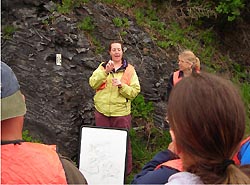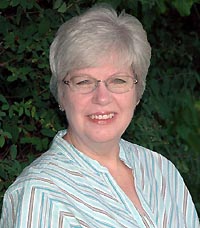Student Features
Signs of Science
07.27.06
|
Who Are NASA's Earth Explorers? The elementary school student wondering how El Niño will affect tomorrow's weather. The scientist studying connections between ozone and climate change. And the farmer using satellite pictures to keep track of crops. All of these people are Earth Explorers -- they are all curious about the Earth system. This monthly series will introduce you to NASA Earth Explorers, young and old, with many backgrounds and interests. Nominate an Earth Explorer! Tell us about the Earth Explorers you know. We're looking for students, teachers, scientists and others who are working with NASA Earth science data and imagery to better understand our home planet. Send your nominations to Dan Stillman: dan_stillman@strategies.org. |

|
| Image above: Geologist Michele Cooke uses sign language to talk about the folded rocks. Credit: Mary Ellsworth |
Many people learn best by seeing and doing, especially those who can't hear. People who can't hear are called deaf. Teresa Huckleberry teaches science at a school for the deaf. She says, "It is important that students learn to do science, not just read about it in a book."
Reading is not always easy for some people who are deaf. Many find it hard to read and write in English. They have this problem because English is not their first language. American Sign Language is the language they use most. Sign language is a way of talking with your hands. It doesn't have the same rules as English.
Huckleberry uses sign language to teach science. Every word has its own sign. Several signs together make a sentence. However, English or sign language words are not always enough to explain the Earth. Often the best way to learn about Earth science is to see what you are studying up close.
|
Related Resources + Deaf Women and Men in Science + Previous Earth Explorers Articles |
Of course, not every day can be a field trip. But even at school, learning about Earth can be fun. Huckleberry's students go outside to measure how clean the air is. They grow plants inside their classroom. They also spend time on the computer. They go to a Web site where they read about scientists who are deaf. They learn that you can be good at science even if you can't hear.
There have been many deaf scientists. Some are famous. Henrietta Leavitt was deaf. She studied the light from stars. Charles Bonnet was also deaf. He discovered how caterpillars and butterflies breathe. The great Thomas Edison was hard-of-hearing. He invented many things, including the light bulb.

|
| Image above: Teresa Huckleberry teaches at the Indiana School for the Deaf. Credit: Teresa Huckleberry |
Rock (or stone)
+ View movie
+ Download viewer
Earth
+ View movie
+ Download viewer
Scientist
+ View movie
+ Download viewer